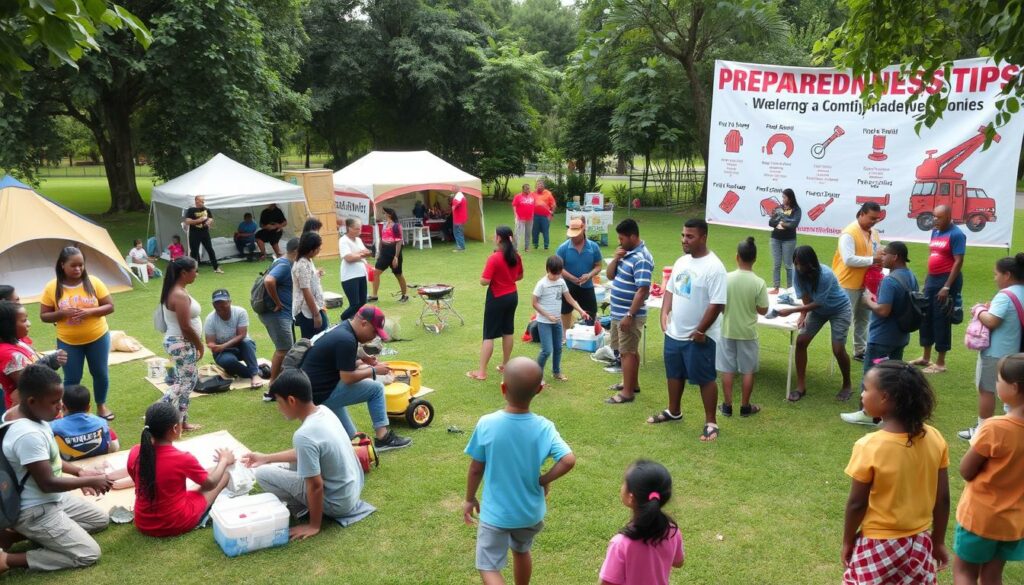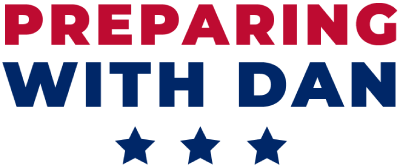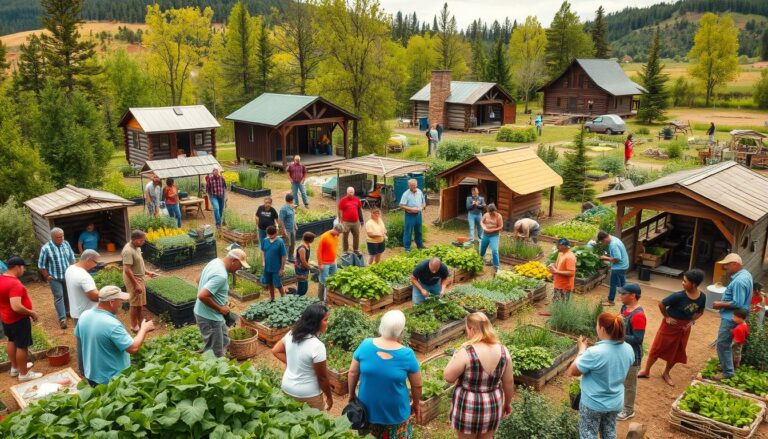In today’s world, being prepared is more important than ever. We face natural disasters and societal changes. The prepper community stands for self-reliance and helping each other. It’s about working together to overcome challenges.
The core of the prepper community is self-sufficiency, strength in numbers, and being ready for anything. By working together, preppers share skills and knowledge. This makes everyone in the community stronger and more likely to survive.
Many things make people want to be prepared, like natural disasters and fear of war. The variety of skills in a community makes it more resilient. Almost 80% of people feel safer knowing they have a supportive network during tough times.
Key Takeaways
- The prepper community prioritizes self-sufficiency, collective strength, and adaptability.
- Modern challenges such as economic instability and natural disasters drive the need for preparedness.
- Diverse skills within the community enhance overall survival and resilience.
- A strong network can reduce individual scarcity by up to 40% during disasters.
- Nearly 80% feel more secure being part of a mutually supportive community.
Understanding Community Preparedness
Community preparedness is key to tackling today’s survival challenges. These include natural and man-made disasters. A prepper community values self-sufficiency, collective strength, and adaptability. By coming together, we can share resources like food, knowledge, and security, making survival in emergencies easier.
The Importance of Collective Action
Working together is essential for emergency preparedness. Community Preparedness Groups can cut down recovery time and offer quick help during disasters. This leads to faster neighborhood responses. The Mississippi Emergency Management Agency suggests forming such groups to boost local emergency readiness.
In emergencies, it can take hours or days for authorities to arrive. This shows how vital local preparedness is.
Benefits of a Preparedness Network
Building a survival network has many advantages. Using phone chains, social media, and email lists can strengthen neighborhood safety. It’s also key to pick places like schools or churches for emergency meetings.
Don’t forget to plan for those who might need extra help. This includes the elderly, families with young kids, and people who don’t speak English well.
Research shows that active community involvement boosts disaster response rates. NYC Emergency Management helps local groups get better at preparing for emergencies. The Community Preparedness Boot Camp teaches community organizations how to plan better for emergencies.
Community preparedness involves seven key areas: information, networks, communication, resources, decision-making, self-organizing, and inclusion. Using what we already have in our communities can make planning more effective. This approach fits with complexity theory, which says change comes from working together and participating.
Establishing a Local Prepper Group
Starting a local prepper group needs careful planning and determination. It starts with finding people who want to be prepared and feel part of a community.
Finding Like-Minded Individuals
Finding the right people is essential for a strong prepper group. Talking casually with neighbors about current events and shared concerns can help. About 50% of people might show up to a meeting, so don’t expect everyone to come.
Using platforms like Eventbrite and social media can help attract more people. Remember, preppers might not want to talk openly about their activities. Using terms like “self-sufficiency” can make them feel more comfortable and increase interest by 20-30%.
Building trust and sharing knowledge without prying is key. This helps everyone support each other better.
Setting Group Goals and Objectives
Keep meetings short, under 90 minutes, to keep everyone engaged. Having clear goals helps everyone work together. Goals might include stockpiling, making escape plans, or learning survival skills.
- Creating an emergency communication plan
- Organizing monthly workshops on various preparedness topics
- Partnering with local emergency services like the Red Cross, which can increase knowledge by 40%
Make sure the group’s plans fit the needs of everyone. Seniors, the disabled, and parents need different solutions. A supportive and friendly group helps everyone feel ready for emergencies.
Having a positive atmosphere is key. Using stories to motivate can make a big difference. Stories can increase information retention by up to 60%.
Keep records of meetings to improve future ones. Even a few dedicated members can make a big difference in building a strong community.
Core Principles of Emergency Preparedness
Effective emergency preparedness relies on key principles. These ensure communities are ready for various challenges. They focus on risk assessment, resource allocation, and communication plans for crisis coordination.
Risk Assessment and Resource Allocation
Risk assessment is key in emergency management. It helps communities identify threats and plan better. This is vital for fair resource management, helping vulnerable groups like communities of color.
Resource management should include everyone’s needs. It’s important to allocate resources like water, food, and land well. Studies show that with enough funding, disasters can be less costly and less damaging.

Planning Drills and Simulations
Drills and simulations are key to test how well the community responds. The American Red Cross aims to help over 50 California communities get ready for disasters. Begin planning drills three months early to cover all bases.
- Set clear goals and pick the right event format.
- Finalize the program and send out flyers 2-3 months early.
- Invite people 4-6 weeks before the event.
On the day of the event, start checking in two hours early. This helps set up and confirm important details like food vendors. After the event, collect feedback to see how well it went. Working with local groups like CalEMA and the Red Cross can make the event more impactful.
Inviting Expert Speakers to Share Insights
Bringing in experienced speakers adds great value to the event. Plan for speakers well in advance. Here’s how:
- Find and invite experts three months early.
- Confirm their schedules and topics 2-3 months ahead.
- Advertise the event online and in local papers.
The “Prep Rally” Disaster Preparedness Fair is a good example. It has press conferences and then the main event. Afterward, it’s important to gather feedback to see how well the event worked. The 2023 EDEN COAD Manual can help improve disaster response.
Preparedness events give real-world practice to test emergency plans. High turnout shows community dedication. But, it’s key to keep people engaged all the time. Creating a COAD can make responses better and lessen social and economic effects.
Establishing a Food Security Plan
Food security is key for community preparedness. A good food security plan ensures everyone has what they need in emergencies. It includes gardening, sharing food, and bartering. These steps help communities be self-sufficient and build stronger bonds.
Community Gardens: A Collaborative Effort
Community gardens boost food security. By gardening together, people grow fresh food. This effort not only gives everyone healthy food but also brings the community closer.
In cities, gardens turn empty spaces into green areas. This helps the environment and makes food available.
- Promotes local food production.
- Strengthens community bonds through shared effort.
- Contributes to environmental sustainability by utilizing urban spaces.
Food Storage Sharing and Bartering Systems
Food sharing and bartering are vital for food security. They ensure everyone gets what they need. These systems also keep a steady supply of food, important in tough times.
- Encourages equitable resource distribution.
- Helps communities maintain essential supply stockpiles.
- Fosters self-sufficiency through bartering systems.
Understanding food needs is important. On average, each person eats about 1 pound of food daily, or 1600 calories. To figure out a community’s food needs, multiply the population by this amount.
| Daily Food Consumption | Stockpile Calculation |
|---|---|
| 1 pound per person (1600 calories) | Total Population x Daily Consumption Rate |
Regular checks and monthly reviews help manage food well. Agencies like the Department of Health and Social Services and the Federal Emergency Management Agency support these efforts. They show how important teamwork is in food security.
- Monthly inventory checks for optimal management.
- Reduced risk of foodborne illnesses with proper storage.
- Support from various agencies for enhanced food security.
Enhancing Disaster Response Capabilities
Improving a community’s disaster response is key to keeping its members safe and strong. Having teams ready for different disasters makes a big difference. It boosts preparedness and helps everyone work together better.
Developing Emergency Response Teams
It’s vital to have teams that can act fast and well in emergencies. Training is a big part of getting ready. Team members should practice with drills that mimic real disasters.
This practice makes them ready to tackle challenges head-on.
Creating First Aid and Medical Response Resources
A community’s ability to handle injuries and health issues in disasters depends on its medical setup. It’s important to have strong first aid and medical systems. These need to be updated with new techniques and supplies.
Doing this helps save lives and lowers the number of injuries during disasters.
Due to preparedness measures established after the 2004 Indian Ocean Tsunami, few lives were lost during Super Cyclone Phailin in 2013.
In short, making disaster response better by setting up teams and medical resources helps communities face crises. This effort, through training and managing resources, is essential for effective disaster response.
Evaluating Community Preparedness Regularly
It’s key to check how ready a community is for emergencies often. This helps spot where they can get better and keep up with new dangers. These checks bring people together, making the community stronger.
Conducting Assessments and Feedback Sessions
Doing deep checks and listening to what people say is vital. FEMA says it’s important to use risk analysis and local checks in planning. This helps make better decisions for the community.
Hospitals and health agencies must check in with their communities every few years. This keeps their plans fresh and ready for anything. The CASPER method is a quick way to learn what the community needs, helping plans stay sharp.
Adjusting Plans Based on Community Needs
Changing plans to fit what the community needs is ongoing. Using data from checks and feedback helps make plans better. The Social Vulnerability Index helps find where help is most needed.
Getting people from all walks of life involved makes plans better. Schools with safety drills see students get more involved. In rural areas, working together is key to success.
Regular checks and using feedback make plans better and stronger. This helps communities respond well to emergencies.
Utilizing Technology for Better Coordination
In today’s world, using technology is key for better community readiness. Apps and social media help communities plan and share info better. These tools keep communication flowing and strengthen community ties, vital for quick emergency responses.
Tools for Communication and Planning
Tools like the National Emergency Response Information System (NERIS) are vital for secure data and teamwork among safety officials. S&T’s tests ensure tech meets standards, helping teams work together better. The EMPOWER program gives first responders live weather updates, making them ready for bad weather.
Also, programs like HExCAT quickly analyze health effects from explosions, showing the need for fast data in emergencies. The WIFIRE Edge uses AI for firefighting, making responses faster and more effective.
Social Media as a Resource for Building Community
Social media is a strong tool for building community. Sites like Facebook, Twitter, and Instagram help spread info fast and unite people. For example, Thailand’s Mr. Warning network uses social media to connect over 28,000 members across 3,340 villages.
In Cambodia, EWS 1294 keeps 93,000 people informed in 21 provinces. Laos’ SMS system, started in 2019, shows a move to digital over old methods. These tools make sure info gets out quickly, helping teams work together better.
| Program | Features | Impact |
|---|---|---|
| NERIS | Secure cloud-based fire data management | Improved interoperability |
| EMPOWER | Real-time weather data | Enhanced first responder readiness |
| HExCAT | Rapid explosion impact analysis | Timely emergency response |
| WIFIRE Edge | AI and edge computing for firefighting | Real-time data analysis |
| Mr. Warning Network | Social media engagement | 28,000 members, 3,340 villages |
| EWS 1294 | Real-time communication | 93,000 subscribers |
Fostering Community Resilience
Community resilience is key for national health security. It covers physical readiness and mental well-being. The National Health Security Strategy says resilience cuts down recovery times after emergencies. This saves resources at all levels.
But, we’re working on how to build community resilience. We need to improve collaboration and sharing of resources.
Promoting Mental Health and Well-being
Mental health is vital for community resilience. Support groups and stress-relief activities help people deal with emergency stress. These efforts help communities face and lessen disaster stress.
Factors like physical and mental health, social and economic well-being, and risk communication matter. Communities with strong social networks and healthcare do better after disasters. By helping vulnerable groups and improving public health, communities get stronger and see fewer deaths and illnesses during emergencies.
Celebrating Achievements and Building Morale
Keeping morale high is important for community unity and motivation. Celebrating successes strengthens community bonds. Events, recognizing contributions, and sharing wins create a positive vibe.
This boosts resilience by fostering social connections and disaster readiness. These efforts build a strong framework for both physical and mental resilience. It’s essential for overcoming challenges.
Source Links
- https://tac-skills.com/prepper-community-strategies/
- https://offgridsurvival.com/prepper-communities-building-a-survival-network-in-troubled-times/
- https://www.msema.org/preparedness-2/community-preparedness/
- https://www.nyc.gov/site/em/ready/community-preparedness.page
- https://knowledge.aidr.org.au/resources/ajem-april-2023-understanding-community-led-disaster-preparedness/
- https://thesurvivalmom.com/get-family-friends-board-prepping/
- https://roguepreparedness.com/how-to-find-prepper-groups/
- https://naacp.org/resources/core-principles-equity-and-emergency-management
- https://www.unr.edu/organizational-resilience/phases
- https://www.domesticpreparedness.com/articles/three-puzzle-pieces-that-increase-community-preparedness
- https://www.ready.gov/kids/national-strategy
- https://extension.psu.edu/a-community-approach-to-disaster-preparedness-and-response
- https://www.ncoa.org/article/emergency-preparedness-for-community-based-organizations-delivering-evidence-based-programs/
- https://www.redcross.org/content/dam/redcross/atg/Chapters/Division_2_-_Media/Bay_Area/Bay_Area_-_PDFs/Preparedness_Event_Toolkit.pdf?srsltid=AfmBOorhmLbH4P2ZIKnGhCxzWtoDyMkRrZH18KUepCcseekeJHK19p_T
- https://extensiondisaster.net/hazard-resources/community-economic/community-organizations-active-in-disaster/
- https://www.sccmo.org/1343/Organizational-Preparedness
- https://www.uaf.edu/ces/districts/juneau/food-security/template/
- https://gfs.com/en-us/ideas/emergency-preparedness-starts-planning/
- https://www.fema.gov/blog/food-safety-recipe-national-preparedness
- https://www.undrr.org/enhancing-disaster-preparedness-effective-response
- https://www.unisdr.org/campaign/resilientcities/home/article/essential-nine-ensure-effective-disaster-response.html
- https://pmc.ncbi.nlm.nih.gov/articles/PMC4187313/
- https://www.ruralhealthinfo.org/toolkits/emergency-preparedness/2/community-planning
- https://servoxy.ca/blogs/news/the-vital-role-of-community-preparedness-in-emergencies?srsltid=AfmBOoq1yq7sin9XqBIegy8sx_0xKabWZdvKC07yWuHqm5NYJGq6YWxQ
- https://pmc.ncbi.nlm.nih.gov/articles/PMC3780560/
- https://www.dhs.gov/science-and-technology/preparedness-through-innovation
- https://www.cdri.world/blogs/using-technology-better-disaster-preparedness-and-building-resilience
- https://pmc.ncbi.nlm.nih.gov/articles/PMC4945213/
- https://urbanfootprint.com/community-resilience-meaning/
- https://bmcpublichealth.biomedcentral.com/articles/10.1186/s12889-023-17458-x

